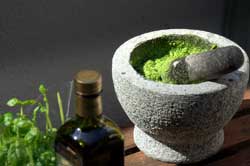Ligurian food and wine
 Ligurian cuisine is rich and varied, the traditions of the sea are linked to those of the hinterland and to the exotic flavors brought here by centuries-old trade. It is historically a “poor” cuisine but one of the richest in variety in the Mediterranean.
Ligurian cuisine is rich and varied, the traditions of the sea are linked to those of the hinterland and to the exotic flavors brought here by centuries-old trade. It is historically a “poor” cuisine but one of the richest in variety in the Mediterranean.
Oil, focaccia and pesto
Olive trees, in Liguria, were introduced by Benedictine monks 800 years ago and today, there are three DOPs for Ligurian oil: Riviera dei Fiori , Riviera del Ponente Savonese and Riviera di Levante .
The inevitable extra virgin olive oil is a basic element of Ligurian cuisine and is also used to prepare focaccia genoves and focaccia di Recco . Different from each other, they are both made with flour, water, salt and (a lot) of oil, ingredients to which the focaccia di Recco adds crescenza, replacing the fishermen's cheese.
 Then there is pesto , a sauce that dates back to two hundred years ago, today a symbol of Ligurian cuisine, prepared with basil, extra virgin olive oil, salt, Parmesan cheese, pecorino, garlic, and pine nuts. Genoese basil PDO belongs to the Ocimum basilicum L species. and it is grown in the greenhouses of the hills of Pra and Voltri , as well as in the hinterland of Diano Marina .
Then there is pesto , a sauce that dates back to two hundred years ago, today a symbol of Ligurian cuisine, prepared with basil, extra virgin olive oil, salt, Parmesan cheese, pecorino, garlic, and pine nuts. Genoese basil PDO belongs to the Ocimum basilicum L species. and it is grown in the greenhouses of the hills of Pra and Voltri , as well as in the hinterland of Diano Marina .
To be "good" it must be grown near the sea, because the one inside tastes like mint. Pesto is ideal for dressing trofie, which in ancient times were made with wheat flour mixed with chestnut flour, cheaper and more available. In Genoese minestrone, pesto is put without the pine nuts, as it is a dish cooked with only vegetable elements.
